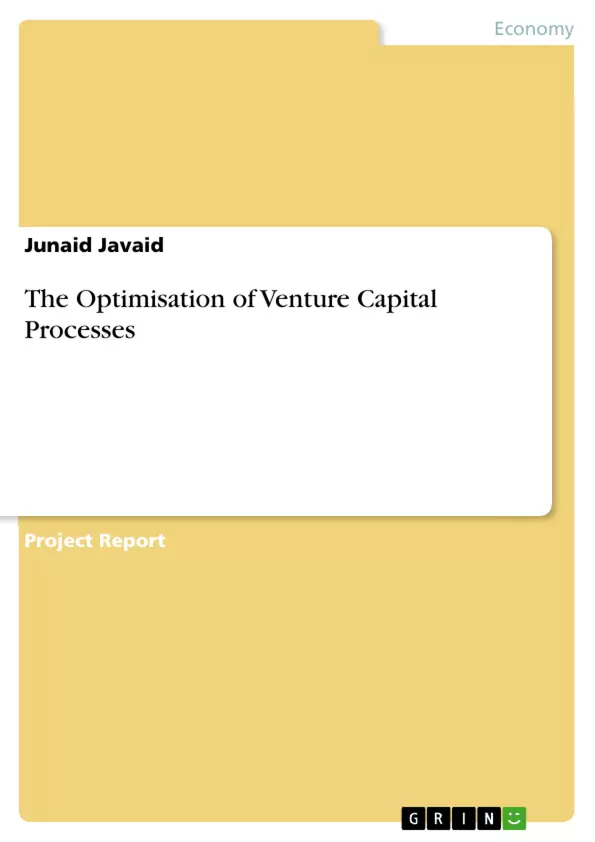This dissertation is written on the topic of “Optimisation of Venture Capital Processes": The scope of this dissertation is broad as it will closely signify and analyse all the important factors incorporated within the process of venture capital and would direct the underlying venture backed company towards the way of optimisation It has been observed that venture capital is frequently perceived as a synonym of private equity. According to Bygrave & Timmons (1992), the venture capital process is composed of four different phases (Investment Decision, Contracting, Control & Value Adding and Exit). The investment decision phase is much significant and is also time consuming. In relation to Contracting aspect, it has been assumed the each negiotated contract would be distinctive from each other and it would happen as a result of variation in term of assigning of control right adequate to that specific investment. With respect to Control & Value Adding aspect, It has been ascertained that through their active participation in the governance, aspect would have an opportunity in transfering their resources & competencies to the company in which they have invested. Therefore, major reason behind the significance of exit strategy in the venture capital is that in the earlier phases of development it seems very rare for the company to pay dividends to its shareholders. From the results of Investment Decision cases of all companies that there are three kinds of approaches (NPV, IRR and Real Options) that could be adopted for the purpose of estimating the value of companies’ projects backed by venture capital From the research paper on contracting factor, It has been discovered that important terms (regarding the composition and form of financial claims held by the entrepreneurs and venture capitalists) seemed to depend more on the size of underlying venture capital market size. From the case study on Control & Value Adding, it has been indicated that there is a direct relationship exists among the venture capitalists’ active participation and the performance of entrepreneurial companies. From the Journal on Exit Strategies, it has been observed that IPO is determined as exensively pursued exit strategy. However, trade sale is regarded as second preferred exit strategy. [...]
Inhaltsverzeichnis (Table of Contents)
- Abstract
- Table of Contents
- Contents of Tables & Figures
- Introduction
- Literature Review
- What is Venture Capital?
- Venture Capital and the Financial Landscape
- Venture Capital Companies' Structure
- Actors & Relationships within Venture Capital
- Venture Capital Process
- Investment Decision
- Conventional Common Method
- Real Options
- Contracting
- Venture Capital's Market Size
- Exit Strategy
- Risk & Uncertainty
- Capital Market Timing
- Control and Value Adding
- Exit
- Initial Public Offering (IPO)
- Trade Sale
- Secondary Sale
- Buyback or Management Buyout (MBO)
- Reconstruction, Write-off, Bankruptcy or Liquidation
- Reseach Aim, Questions & Objectives
- Research Aim
- Research Questions
- Research Objectives
- Methodology, Data Collection, Analysis & Results
- Methodology
- Data Collection
- Analysis
- Investment Decision
- NPV Method
- Internal Rate of Return (IRR)
- Real Options
- Research Paper on Contracting
- Case Study on Control & Value Adding
- Journal Article on Exit Strategy
- Results
- Discussion, Conclusion & Recommendations
- Discussion
- Conclusion
- Recommendations
- References
- Contends of Figures & Tables
- The four phases of venture capital (Investment Decision, Contracting, Control & Value Adding, and Exit)
- The importance of optimizing venture capital processes for entrepreneurial success
- The role of various valuation methods (NPV, IRR, Real Options) in investment decision-making
- The impact of venture capital market size on contracting terms
- The relationship between venture capitalists' active participation and the performance of entrepreneurial companies
Zielsetzung und Themenschwerpunkte (Objectives and Key Themes)
This dissertation aims to explore the intricacies of venture capital processes, focusing on their optimization for venture-backed companies. It seeks to establish a comprehensive understanding of the relationships between venture capitalists and entrepreneurs within the venture capital landscape.
Zusammenfassung der Kapitel (Chapter Summaries)
The dissertation delves into the complexities of venture capital processes, starting with a thorough introduction to the concept and its significance in the financial landscape. It then explores the structure of venture capital companies and the key players involved. The subsequent sections delve into the core phases of the venture capital process, namely the investment decision, contracting, control and value adding, and exit.
The investment decision chapter examines various valuation methods commonly employed, including NPV, IRR, and Real Options. The contracting chapter highlights the role of venture capital market size and the importance of exit strategies, risk management, and capital market timing in contract negotiation. The control and value adding section discusses the active participation of venture capitalists in the governance of portfolio companies and the potential benefits of knowledge transfer. Finally, the exit chapter explores various exit strategies, including IPOs, trade sales, secondary sales, buybacks, and liquidation.
Schlüsselwörter (Keywords)
This dissertation revolves around the core concept of venture capital processes and their optimization. It delves into the relationships between venture capitalists and entrepreneurs, focusing on key aspects like investment decision-making, contracting, control and value adding, and exit strategies. The research examines various valuation methods, such as NPV, IRR, and Real Options, and explores the influence of venture capital market size on contracting terms. The study also investigates the impact of venture capitalists' active involvement on entrepreneurial company performance and examines different exit strategies, including IPOs, trade sales, and buybacks.
- Citar trabajo
- Junaid Javaid (Autor), 2014, The Optimisation of Venture Capital Processes, Múnich, GRIN Verlag, https://www.grin.com/document/280857



